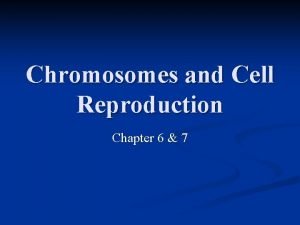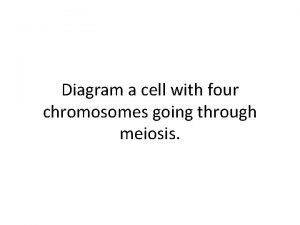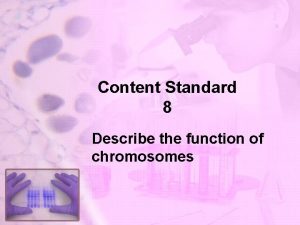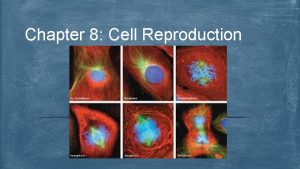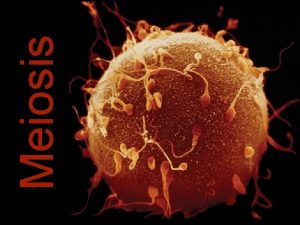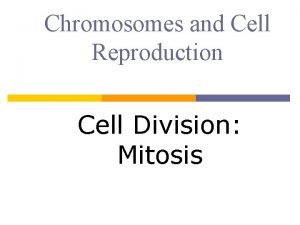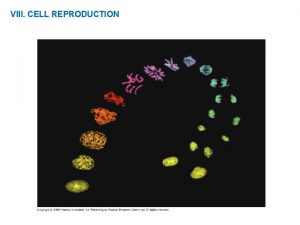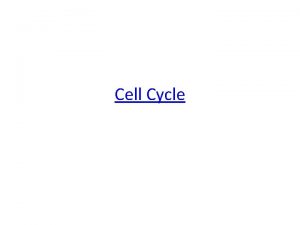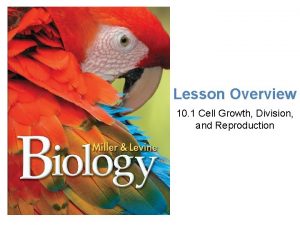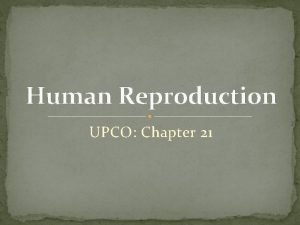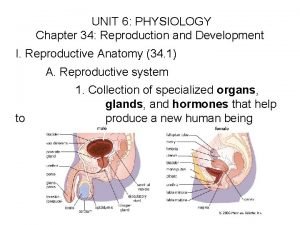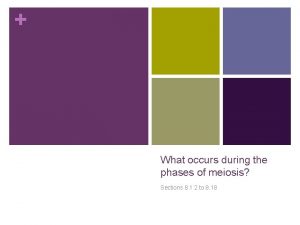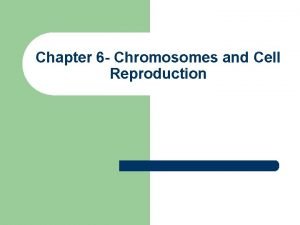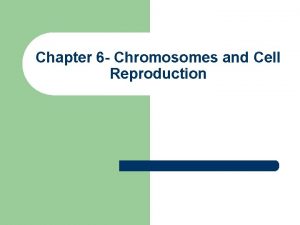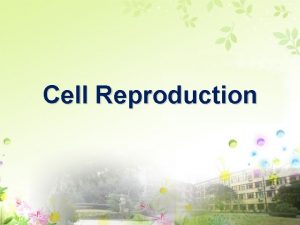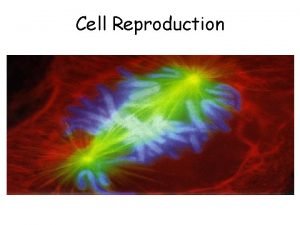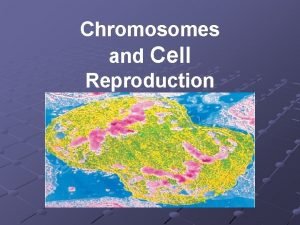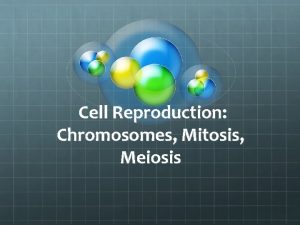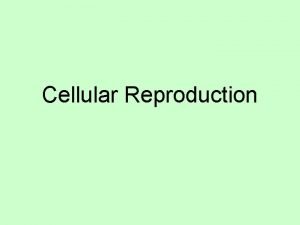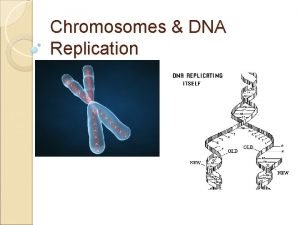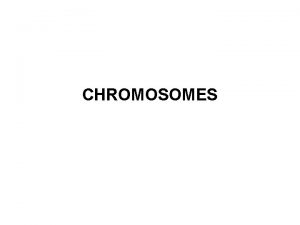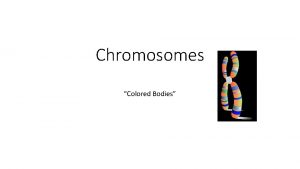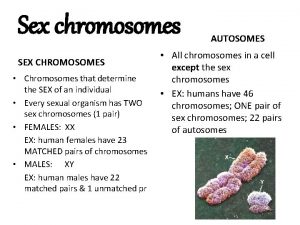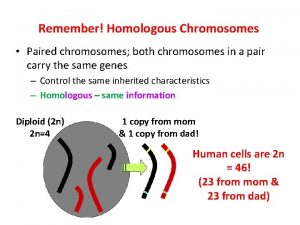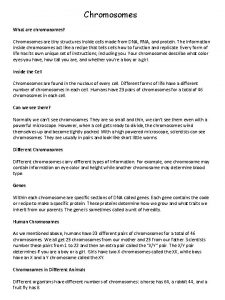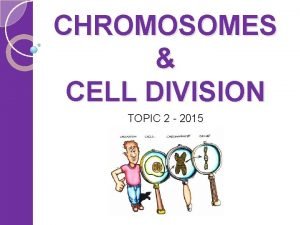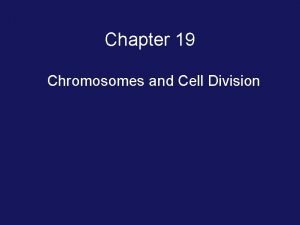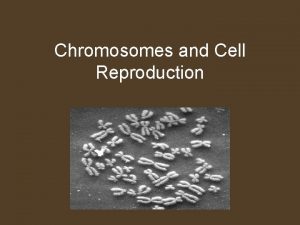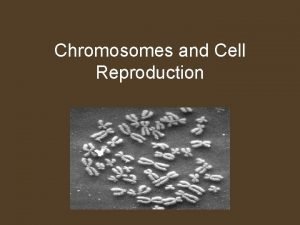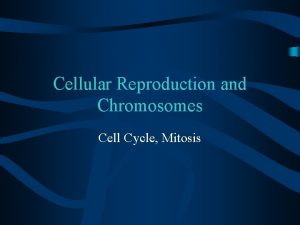Cell Reproduction Chapter 8 8 1 Chromosomes Cell


























- Slides: 26

Cell Reproduction Chapter 8

8 -1 Chromosomes Cell Reproduction 8 -2 Cell Division 8 -3 Meiosis

DNA: Chromosomes l Centromere DNA: l l Chromatid l Copy Chromatid l Nucleotides Genes Forms In Eukaryotes: 1. Chromosome Coiled DNA • Histone proteins • Nonhistone proteins • Centromere 1. Chromatin DNA plus protein • Loose storage Chromosome Prokaryotes l Single circular molecule

**Revisiting DNA** Structure Nucleic Acid Nucleotide

Chromosome Structure & Numbers DIPLOID NUMBER

DNA Structure Eukaryotic Prokaryotic Structure of DNA while not replicating chromatin

Types & Organization of Chromosomes l l Sex Chromosomes: l 2 chromosomes l Determines gender l XX= female l XY= male l Carry genes Autosomes: l 44 chromosomes l All other chromosomes Homologous Chromosomes l Pairs carrying genes for same trait Karyotype: l 22 pairs homologous autosomes l 2 sex chromosomes

**Karyotype** What type of organism is this? What sex is this organism? Does this organism have any chromosomal abnormalities?

Cells & Chromosomes l Diploid (2 N) l Both chromosomes in homologous pair l All cells except reproductive cells l Human: l 46 l chrom. = 22 autosome pairs+2 sex chrom Haploid (1 N) l One set of chromosomes from pair l Reproductive Cells: sperm & egg= gametes l Sperm + Egg = zygote (2 N) l Human l 23 chrom= 22 autosomes + 1 sex chrom

# of Chromosomes in Various Organisms ee Diploid Haploid

Karyotype Analysis 1. Identify this organism? 2. Identify the gender? 3. Determine if this is a normal karyotype?

II. **Cell Division: Prokaryotes ** l Binary Fission: l 2 new genetically identical offspring l 3 stages 1. Chromosome copies itself 2. Cell wall forms between chromosomes 3. Cell splits

Cell Division: Eukaryotes l 2 Types: l Mitosis: genetically identical, 2 N l Meiosis: genetically different gametes, 1 N l Cell Cycle l Interphase = prep!!! l G 1 (Gap 1) Phase l S Phase – SYNTHESIS OF DNA l G 2 Phase l Or G 0 Phase: after G 1, exit cell cycle, no division l Mitosis (M phase) l Cytokinesis (C phase)

**Cell Cycle**

**Mitosis Phases** 1. Prophase l Chromosomes form l Nucleolus & nuclear envelope disappear l Centrosomes (contain centrioles) separate to opposite poles of cell l Spindle fibers make mitotic spindle l Kinetochore fibers attach to kinetochore in chromosome l Polar fibers

2. Mitosis Phases Metaphase l 3. Anaphase l 4. Chromatids separate “chromosomes” Telophase l l Chromosomes line up on midline Spindle fibers disappear Chromosomes chromatin Nucleolus and nuclear envelope reforms Cytokinesis: l l l Cytoplasm divides in telophase Cleavage furrow in cell membrane Cell plate: plant cells

**Mitosis** Diagram http: //en. wikipedia. org/wiki/File: Mitosis_drosophila _larva. ogv

**Cytokinesis: Cleavage Furrow & Cell Plate

**Meiosis**: Reproductive Cells Only l l l Forms gametes (1 N) from diploid cells (2 N) l 4 genetically different haploid cells Meiosis I: haploid cells form by end http: //highered. mcgrawl Prophase I hill. com/sites/0072495855/student_vie w 0/chapter 28/animation__how_meiosis l Synapsis tetrad _works. html l **Crossing over** genetic recombination l Metaphase I l Anaphase I l Independent assortment l Telophase I Meiosis II: l Prophase, Metaphase, Anaphase, Telophase II

**Meiosis I**

**Meiosis II (con)**

Spermatogenesis In testes l Produces 4 genetically different haploid spermatids l Spermatids mature into sperm l

Oogenesis In ovaries l Produces l Unequal l 1 Egg Cytoplasm l 3 Polar Bodies Division

Spermatogenesis vs Oogenesis

**Mitosis vs Meiosis**

Asexual & Sexual Reproduction l Asexual l Offspring from 1 parent l Unicellular mitosis or budding l Multicellular budding l Always l genetically identical to parent Sexual l Offspring results from union of gametes= zygote l Offspring genetically different from parents due to meiosis recombining genes l Allows species to adapt more quickly
 Chapter 6 chromosomes and cell reproduction
Chapter 6 chromosomes and cell reproduction Asexual reproduction cell division
Asexual reproduction cell division Asexualk
Asexualk Venn diagram asexual vs sexual reproduction
Venn diagram asexual vs sexual reproduction Cell with four chromosomes going through meiosis
Cell with four chromosomes going through meiosis What is
What is Cell with 4 chromosomes
Cell with 4 chromosomes Diagram of mitosis
Diagram of mitosis Cell reproduction
Cell reproduction Asexual reproduction cell division
Asexual reproduction cell division Cell cycle and replication
Cell cycle and replication Cell reproduction
Cell reproduction Cell growth division and reproduction
Cell growth division and reproduction Chapter 4 cell theory and cell study
Chapter 4 cell theory and cell study Sexual reproduction
Sexual reproduction Pedigree miscarriage symbol
Pedigree miscarriage symbol Reproduction human
Reproduction human Chapter 9 cellular reproduction
Chapter 9 cellular reproduction Lesson 20.2 the male reproductive system
Lesson 20.2 the male reproductive system Chapter 19 asexual reproduction
Chapter 19 asexual reproduction Chapter 10 sexual reproduction and genetics
Chapter 10 sexual reproduction and genetics Chapter 9 cellular reproduction answer key
Chapter 9 cellular reproduction answer key Chapter 34 reproduction and development answer key
Chapter 34 reproduction and development answer key Chapter 9 cellular reproduction
Chapter 9 cellular reproduction Chapter 8 cellular reproduction cells from cells
Chapter 8 cellular reproduction cells from cells Autosomes vs sex chromosomes
Autosomes vs sex chromosomes Cpalms heredity
Cpalms heredity
